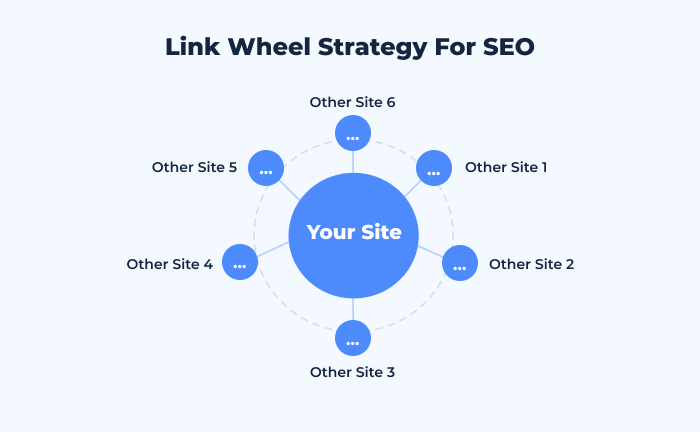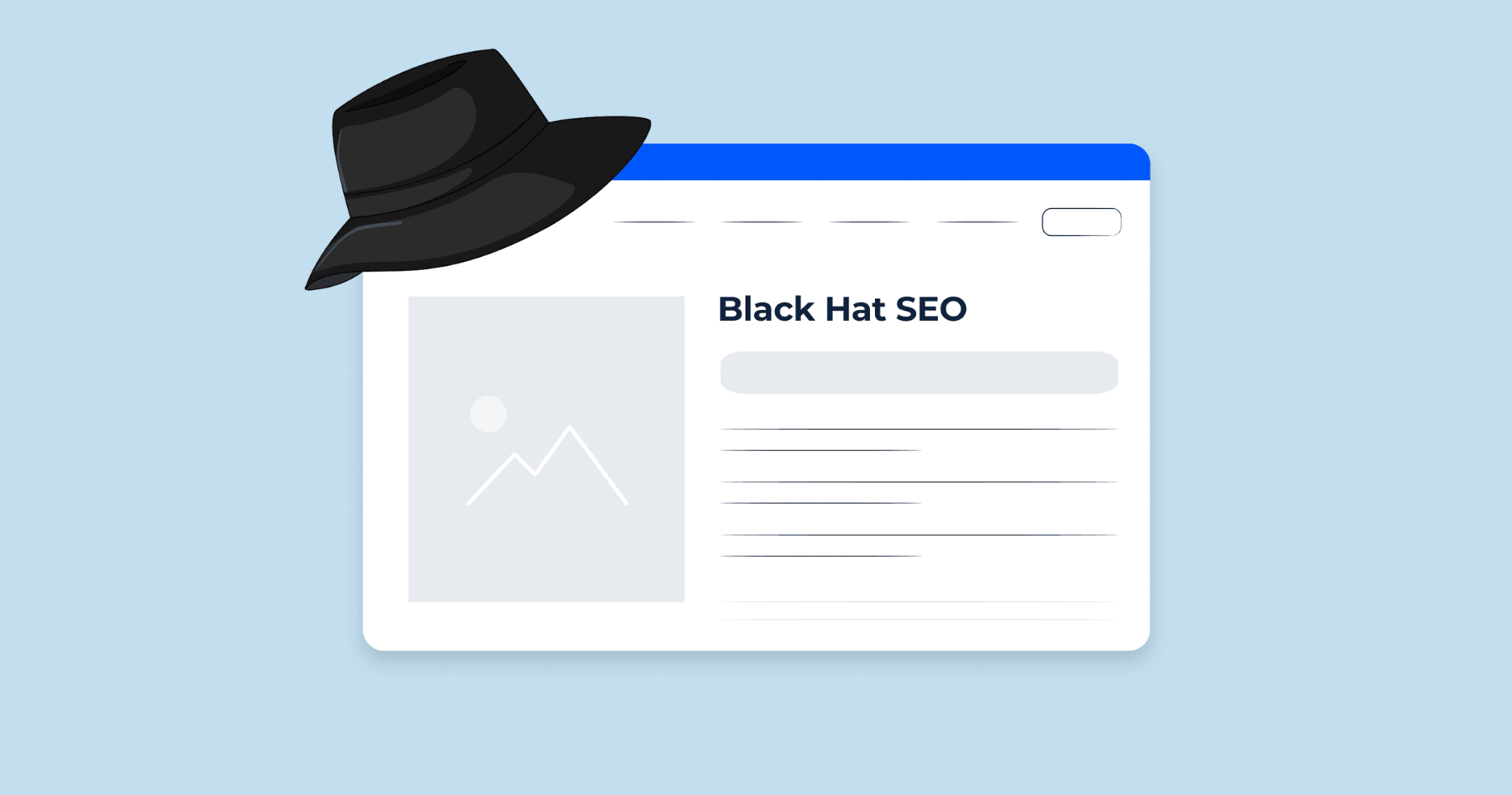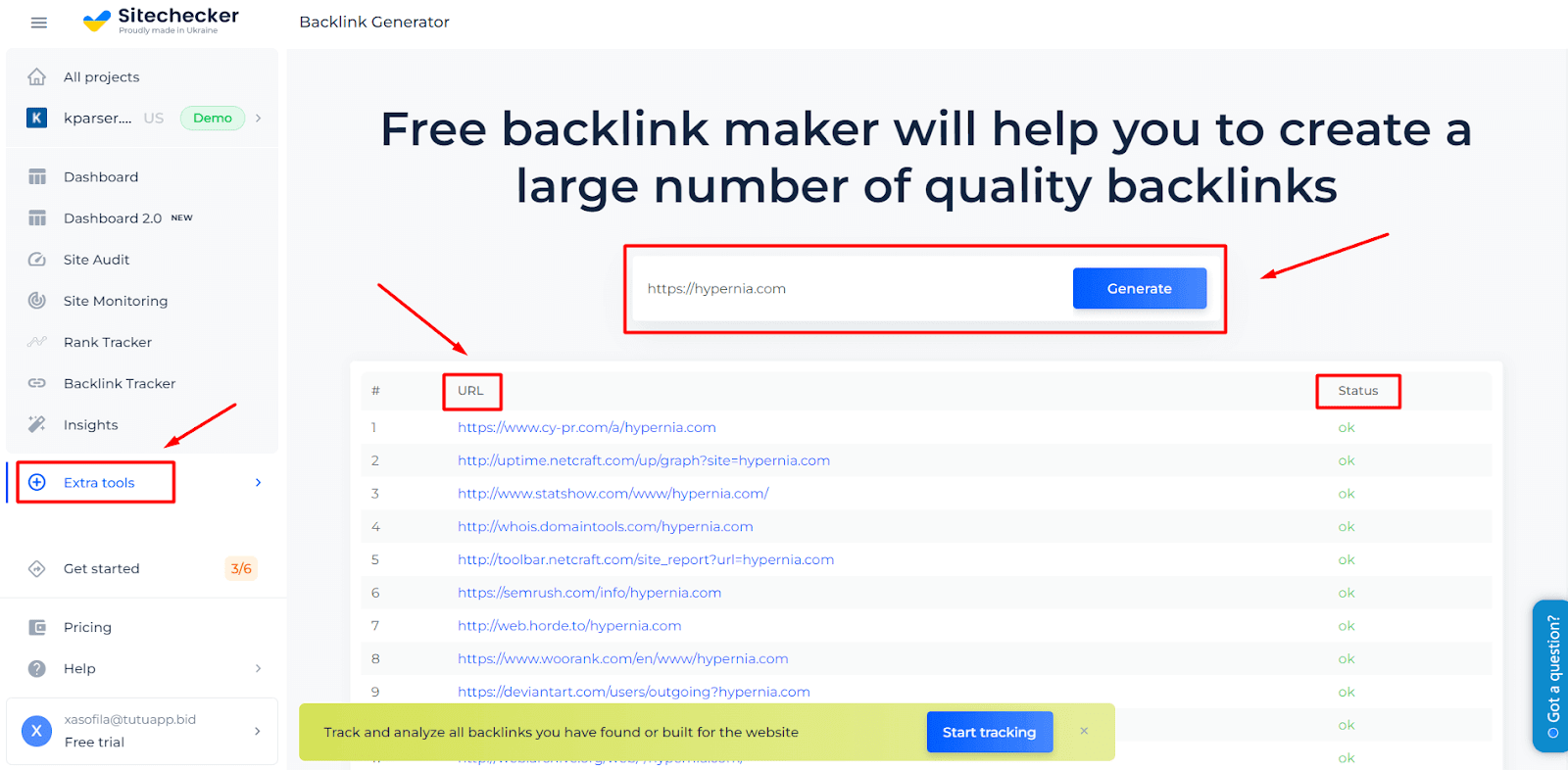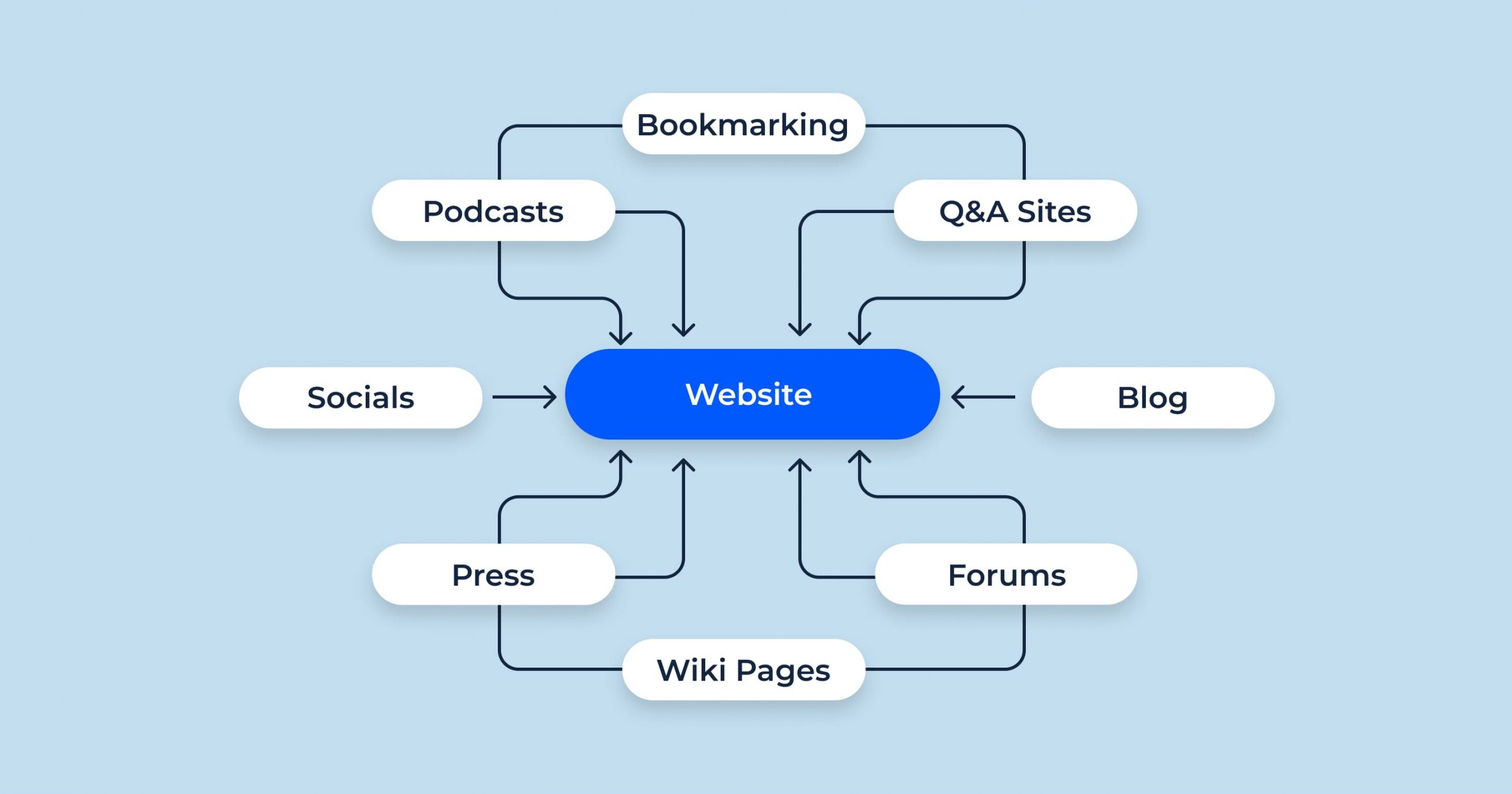What is a Link Wheel in SEO?
A link wheel, in the realm of Search Engine Optimization (SEO), is a strategic method for building backlinks to enhance a website’s authority and search engine ranking. The concept revolves around creating a series of interconnected websites or web properties that point or link to one central website, which is often the main site an individual or business wishes to promote. The idea is to generate a “wheel” of links that channel authority and relevance to the primary site, ultimately boosting its visibility in search engine results.

Let’s break down the components of a link wheel:
- Central Site (Hub): This is the main website or webpage that you aim to rank higher on search engines. The entire link wheel strategy is centered around driving more authority and relevance to this site.
- Satellite Sites (Spokes): These are the outer nodes of the wheel. They can be blogs, social media profiles, or other web properties that you control. Each of these sites will have unique content related to the niche of the central site. They serve as the supporting cast, directing link juice and traffic towards the hub.
- Interlinking: This is the crux of the link wheel strategy. Each satellite site not only links to the central site but also to one or more other satellite sites. This creates a network of interconnected links, forming the shape of a wheel.
The primary advantage of a link wheel is that it leverages the power of multiple web properties to enhance the authority of one central site. By having each of the satellite sites link to the main site and to each other, a flow of link equity is established. This, in theory, helps the main site garner more authority and trust from search engines.
However, it’s essential to note that link wheels must be constructed with care. Search engines, especially Google, are adept at identifying unnatural link-building practices. A well-executed link wheel appears organic and is built upon high-quality, relevant content on each of its nodes. On the other hand, a poorly constructed link wheel can raise red flags, potentially leading to penalties.
In conclusion, a link wheel is a potent SEO strategy when implemented correctly. It harnesses the collective power of multiple web properties to funnel authority and relevance to a primary site, aiming for improved search rankings. As with all SEO techniques, the key lies in ensuring that the approach is genuine, content-driven, and adheres to best practices.
Google About Link Wheels
John Mueller, a Google Webmaster Trends Analyst, has said on Twitter that link wheels are a link scheme and therefore against Google’s Search Essentials. He has also said that they are super old and that Google does not consider them to be a ranking factor.
In a Twitter conversation on October 25, 2022, Mueller was asked about link wheels. He responded:
When asked if he minded that people were doing link wheels, Mueller said:
Link wheels are an outdated SEO technique that involves creating a network of sites and linking them to each other in a circular fashion. The goal is to create the illusion of popularity and authority, which can help to improve a site’s ranking in search results.
However, Google is now aware of link wheels and considers them to be spam. If a site is caught using a link wheel, it could be penalized or even banned from search results.
Therefore, it is important to avoid using link wheels and other black hat SEO techniques. Instead, focus on creating high-quality content and building links naturally.
Link Wheels vs. Blog Networks
The world of SEO is rife with strategies and techniques, each with its nuances and methodologies. Among these, link wheels and blog networks are often brought up in the same conversation, leading to some confusion about their differences and similarities. Let’s delve into these concepts and clarify the distinctions.
Are link wheels just reinvented blog networks?
At a glance, link wheels and blog networks might seem analogous, but they differ in structure, intent, and execution. Both involve using multiple websites or web properties to boost the SEO of a primary site, but that’s where the similarities largely end.
A link wheel is structured like a wheel, where multiple satellite sites (spokes) link to a central site (hub) and often to each other, creating a closed-loop of links. The primary intent is to channel authority and relevance to the hub site.
On the other hand, a blog network, also known as a Private Blog Network (PBN), consists of a group of websites owned by an individual or organization. These websites are primarily used to create backlinks to a main site. Unlike link wheels, the sites in a PBN don’t necessarily interlink with each other.
In essence, while both strategies aim to enhance the SEO of a primary site, link wheels emphasize a structured, interconnected approach, whereas blog networks are more about leveraging multiple domains to build backlinks.
Not all blog networks are black hat
Blog networks, especially PBNs, have garnered a somewhat notorious reputation in the SEO community. This is because many black hat practitioners have misused them, creating low-quality sites solely for backlinking purposes, leading to penalties from search engines.
However, it’s crucial to understand that not all blog networks fall under the black hat umbrella. When a blog network comprises high-quality, relevant sites with unique content, and the backlinking is done judiciously, it can be a white hat technique. The differentiation lies in the intent and execution. Genuine efforts to provide value, coupled with ethical link-building, ensure that a blog network remains within the bounds of white hat SEO.
Link wheels can be a legitimate, strategic, long-term strategy
Link wheels, when done right, can be a formidable long-term SEO strategy. The key lies in ensuring that the satellite sites offer genuine value, with unique and relevant content. Instead of focusing solely on link-building, the emphasis should be on creating a network of high quality websites, sites that naturally boost the authority of the central hub.
Additionally, it’s essential to avoid over-optimization. Excessive use of exact-match anchor texts or rapid, unnatural link-building can raise red flags for search engines.
Benefits of Building a Link Wheel
In the ever-evolving landscape of SEO, creating link wheels have emerged as a potent strategy for enhancing a website’s search engine ranking. When executed correctly, they offer a plethora of advantages. Let’s delve into the key benefits of building a link wheel.
You’ll save money on SEO services
Building a link wheel primarily involves leveraging your own network of websites, which means you have complete control over the content and links. This autonomy reduces the need to invest in expensive third-party SEO services or backlink packages. By taking the reins of your SEO strategy and optimizing your own link wheel, you can achieve desirable results without a hefty financial outlay.
You can reduce most of your social media efforts
While social media remains a powerful tool for brand visibility and engagement, maintaining an active presence across multiple platforms can be time-consuming. A well-structured link wheel can drive significant organic traffic to your main site, reducing the reliance on social media for traffic generation. This doesn’t mean abandoning social media altogether but rather optimizing your efforts and focusing on platforms that yield the highest engagement for your brand.
White hat link wheels won’t get penalized
Search engines, especially Google, are constantly on the lookout for black hat SEO techniques. However, a link wheel built on the foundation of white hat practices, with genuine content and ethical link-building, is less likely to face penalties. Adhering to best practices ensures that your link wheel remains compliant with search engine guidelines, safeguarding your sites from potential demotions in search engine rankings.
Ranking multiple sites for low competition keywords
One of the inherent advantages of a link wheel is the ability to target multiple low competition keywords across the satellite sites. By strategically choosing such keywords for each spoke of the wheel, you can rank multiple sites on the first page of search results. This not only boosts the visibility of your central site on search engine results pages but also establishes authority for the entire network.
Link wheels can generate link power
A well-constructed link wheel acts as a conduit, channeling link equity from the satellite sites to the central hub. This cumulative link power enhances the authority and trustworthiness of the main site in the eyes of search engines, leading to improved search rankings.
Opportunities for monetization
With multiple satellite sites gaining traction and driving traffic, there are ample opportunities for monetization. From affiliate marketing and sponsored content to ad placements, each site in the link wheel can become a revenue-generating asset, supplementing the income from the main site.
Generating organic, targeted traffic
The ultimate goal of any SEO strategy is to drive organic, targeted traffic to a website. A link wheel, with its interconnected network of relevant sites, acts as a magnet for such traffic. By offering valuable content across the link wheel strategies and strategically funneling visitors towards the central site, you can achieve consistent and targeted traffic growth.
Building a link wheel offers a multitude of benefits, from cost savings and reduced social media efforts to enhanced search rankings and monetization opportunities. When executed with precision and adherence to white hat practices, it can be a game-changer in your SEO arsenal.
Challenges and Considerations
The return may not be worth the effort
While link wheels offer a plethora of benefits, it’s essential to weigh the potential returns against the effort required. Building a link wheel involves creating and maintaining multiple websites, producing high-quality content for each, and ensuring they all interlink correctly. For some businesses, especially smaller ones, the time and resources needed might outweigh the benefits, especially if the desired SEO results take longer than anticipated to materialize.
Potential for long-term upkeep
A link wheel isn’t a “set it and forget it” strategy. Each satellite site requires regular updates, monitoring, and maintenance to remain effective and relevant. As search engine algorithms evolve, there might be a need for regular tweaks to the strategy. Furthermore, any downtime or issues on one site can potentially impact the entire link wheel’s effectiveness, necessitating ongoing vigilance.
Risk of being seen as a private blog network by Google
One of the significant risks associated with link wheels is the potential for search engines, particularly Google, to misinterpret the link building strategy as a Private Blog Network (PBN). PBNs, which are often used for black hat SEO techniques, can lead to severe penalties, including de-indexing of websites. Even if the intent behind the link wheel is genuine, it’s crucial to ensure that each site offers unique value and doesn’t appear as a mere duplicate created for link-building purposes.
Creating unique content for multiple sites
Arguably, one of the most challenging aspects of a link wheel is the need for unique, high-quality content across all satellite sites. Replicating content or resorting to low-quality articles can diminish the wheel’s effectiveness and raise red flags for search engines. For businesses, this means investing in consistent content creation, which can be resource-intensive.
Increased SEO workload
While the goal of a link wheel is to enhance SEO, it undeniably increases the SEO workload. Each site within the wheel requires its own set of SEO best practices, from keyword research and on-page optimization to backlink analysis and performance monitoring. This multi-faceted approach can be overwhelming, especially for businesses without a dedicated SEO team.
How to Create an Effective Link Wheel
Building an effective link wheel requires meticulous planning, strategic execution, and ongoing maintenance. Here’s a step-by-step guide on how to create a link wheel that not only boosts your SEO but also adheres to best practices.
Create each website in your wheel with a unique visual design
The effectiveness of a link wheel hinges on the authenticity and distinctiveness of each satellite site. Ensure that every website in your wheel has a unique visual design, layout, and branding. This not only enhances the user experience but also ensures that search engines view each site as a separate, valuable entity, free from duplication or redundancy.
Avoid anything that might be considered “black hat”

While the temptation to expedite results might be strong, it’s imperative to steer clear of any black hat SEO techniques. This includes practices like keyword stuffing, cloaking, and using low-quality content or spun articles. Engage in ethical SEO practices that prioritize long-term gains over short-term wins.
Set strict rules for anchor text
The way you use anchor text within your link wheel can significantly impact its effectiveness. Ensure that you diversify your anchor text, avoiding over-optimization or excessive use of exact-match keywords. Use a mix of branded, generic, and long-tail keywords to make the link profile appear natural and organic.
Collaborate with those having similar goals and ethics
Building a link wheel can be a collaborative effort. If you’re considering partnering with others, ensure that they share similar goals and adhere to ethical SEO practices. This alignment is crucial in maintaining the integrity of the link wheel and avoiding potential pitfalls.
Preplan your link wheel strategy
Before diving into the creation of your link wheel, take the time to map out your strategy. Identify the primary site you wish to promote and the satellite sites that will form the spokes of your wheel. Determine the content themes for each site and how they’ll interlink to create a cohesive network.
Plug-And-Play Link Wheel Plan Template (Inspired by Structure 2)
To streamline the planning process, consider using a link wheel plan template. This tool can help you visualize the structure of your link wheel, identify content gaps, and ensure that each site is optimized for its target keywords. The template can be a simple flowchart or a more detailed document that outlines the objectives, content strategy, and linking pattern for each site.
Consider creating multiple smaller link wheels
Instead of building one large link wheel, consider the merits of creating multiple smaller wheels. These can target different niches or subtopics, providing a more focused approach. Smaller link wheels can also be easier to manage and maintain over time.
Ensure the quality of sites within your wheel
Quality is paramount when building a link wheel. Each site should offer genuine value, with high-quality, relevant content. Regularly review and update the content, ensuring that it remains fresh, accurate, and valuable to your audience.
Don’t accept guest posts
While guest posting can be a valuable strategy in other contexts, within a link wheel, it’s best to maintain control over the content. Accepting guest posts can introduce variability in content quality and might deviate from the strategic intent of the link wheel. Focus on producing in-house content that aligns with your link wheel objectives.
In conclusion, creating an effective link wheel is a strategic endeavor that requires careful planning, execution, and ongoing maintenance. By adhering to best practices and prioritizing quality at every step, you can harness the power of link wheels to boost your SEO efforts.
Types of Websites to Include in Your Link Wheel
Websites you created yourself
When forming a link wheel, one of the most straightforward approaches is to use websites that you’ve created yourself. These sites, often referred to as “satellite sites,” serve as the spokes of your link wheel.
Advantages:
- Complete Control: You have full control over the content, design, and linking strategy, ensuring that everything aligns with your link wheel objectives.
- Branding Consistency: You can ensure that while each site is unique, there’s a consistent branding element that ties back to your main site.
- SEO Alignment: It’s easier to implement SEO best practices and strategies when you’re in control of the entire site.
Considerations:
- Resource Intensive: Creating and maintaining multiple websites can be time-consuming and may require considerable resources, especially if you aim for high-quality content on each site.
- Domain Authority: Newly created sites start with a low domain authority, which can take time to build.
Websites owned by other organizations or individuals
Another approach to building a link wheel is to leverage websites owned by other organizations or individuals. This can include partnerships, collaborations, or even guest posting opportunities.
Advantages:
- Established Authority: Collaborating with websites that already have an established domain authority can give your link wheel a head start.
- Diverse Audience Reach: Partnering with other sites can expose your content to a broader and diverse audience, increasing the potential for organic traffic.
Considerations:
- Less Control: You have limited control over external websites, which might impact the consistency and frequency of your link-building efforts.
- Quality Assurance: Ensuring that the external site maintains content quality and adheres to white-hat SEO practices is crucial to avoid potential penalties.
Wikipedia and other authoritative platforms
Incorporating links from authoritative platforms like Wikipedia or industry-specific directories can significantly boost the credibility of your link wheel.
Advantages:
- High Domain Authority: Websites like Wikipedia have high domain authority, which can channel significant link equity to your main site.
- Credibility Boost: Being referenced on such platforms can enhance the credibility and trustworthiness of your primary site.
Considerations:
- Strict Guidelines: Websites like Wikipedia have stringent guidelines for referencing and linking. It’s essential to ensure that your content is genuinely valuable and meets their criteria.
- Link Stability: Links on platforms like Wikipedia can be edited or removed by other users, so they may not be as stable as links on platforms you control.
In conclusion, while each type of website offers distinct advantages in a link wheel strategy, it’s essential to ensure that the overall approach is cohesive, genuine, and adheres to white-hat SEO practices.
Create Many Quality Backlinks With Free Backlink Generator
The Free Backlink Generator by SiteChecker is a handy tool for website owners and SEO professionals looking to enhance their site’s search engine visibility. In the realm of SEO, backlinks are a vital component, acting as endorsements that can significantly boost a site’s ranking. This tool simplifies the process of acquiring these valuable backlinks by automatically generating them for a specified website. It’s an efficient way to build a backlink profile, especially useful for new websites or those looking to expand their online presence quickly.

This tool doesn’t just generate backlinks; it focuses on creating them on relevant and authoritative sites, which is crucial for the quality of the backlink profile. The Free Backlink Generator also provides users with a report of the backlinks created, including the source websites, which allows for easy tracking and management of these links. This feature is particularly beneficial for monitoring the impact of these backlinks on the website’s overall SEO performance and ensuring that the links contribute positively to the site’s search engine ranking.
Elevate Your SEO: Create Backlinks Instantly!
Generate free backlinks with our tool and set your site up.
Conclusion
In the intricate world of SEO, strategies like link wheels offer a multi-faceted approach to boosting a website’s search engine ranking. While the benefits are numerous, from enhanced domain authority to targeted traffic generation, the challenges are equally present. It’s essential to strike a balance, ensuring that each spoke of the wheel—whether a self-created site, an external collaboration, or a link from an authoritative platform—adds genuine value. As with all SEO endeavors, the focus should remain on providing authentic, quality content that serves the user’s intent. When executed with precision and ethical considerations, a link wheel can indeed be a game-changer in the digital landscape.

